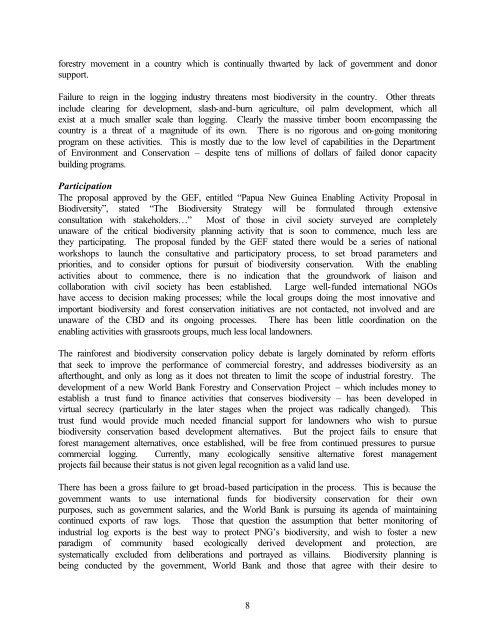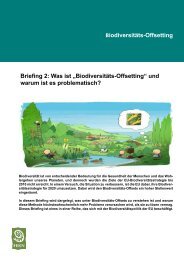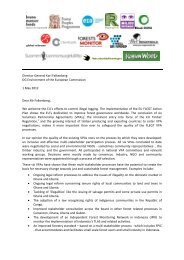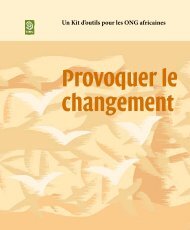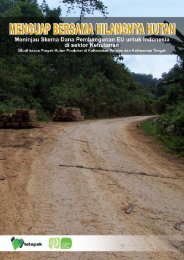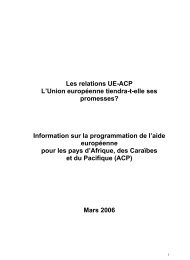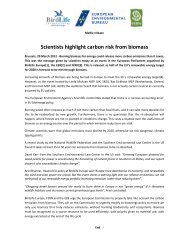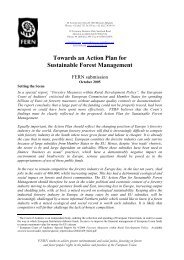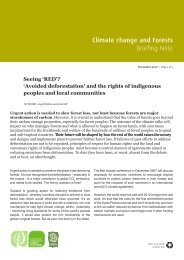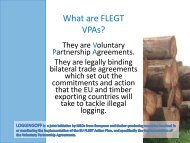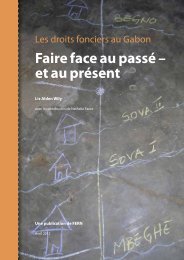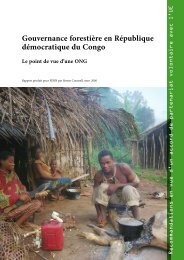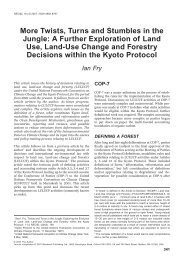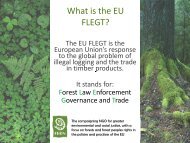Papua New Guinea - Fern
Papua New Guinea - Fern
Papua New Guinea - Fern
Create successful ePaper yourself
Turn your PDF publications into a flip-book with our unique Google optimized e-Paper software.
forestry movement in a country which is continually thwarted by lack of government and donor<br />
support.<br />
Failure to reign in the logging industry threatens most biodiversity in the country. Other threats<br />
include clearing for development, slash-and-burn agriculture, oil palm development, which all<br />
exist at a much smaller scale than logging. Clearly the massive timber boom encompassing the<br />
country is a threat of a magnitude of its own. There is no rigorous and on-going monitoring<br />
program on these activities. This is mostly due to the low level of capabilities in the Department<br />
of Environment and Conservation – despite tens of millions of dollars of failed donor capacity<br />
building programs.<br />
Participation<br />
The proposal approved by the GEF, entitled “<strong>Papua</strong> <strong>New</strong> <strong>Guinea</strong> Enabling Activity Proposal in<br />
Biodiversity”, stated “The Biodiversity Strategy will be formulated through extensive<br />
consultation with stakeholders…” Most of those in civil society surveyed are completely<br />
unaware of the critical biodiversity planning activity that is soon to commence, much less are<br />
they participating. The proposal funded by the GEF stated there would be a series of national<br />
workshops to launch the consultative and participatory process, to set broad parameters and<br />
priorities, and to consider options for pursuit of biodiversity conservation. With the enabling<br />
activities about to commence, there is no indication that the groundwork of liaison and<br />
collaboration with civil society has been established. Large well-funded international NGOs<br />
have access to decision making processes; while the local groups doing the most innovative and<br />
important biodiversity and forest conservation initiatives are not contacted, not involved and are<br />
unaware of the CBD and its ongoing processes. There has been little coordination on the<br />
enabling activities with grassroots groups, much less local landowners.<br />
The rainforest and biodiversity conservation policy debate is largely dominated by reform efforts<br />
that seek to improve the performance of commercial forestry, and addresses biodiversity as an<br />
afterthought, and only as long as it does not threaten to limit the scope of industrial forestry. The<br />
development of a new World Bank Forestry and Conservation Project – which includes money to<br />
establish a trust fund to finance activities that conserves biodiversity – has been developed in<br />
virtual secrecy (particularly in the later stages when the project was radically changed). This<br />
trust fund would provide much needed financial support for landowners who wish to pursue<br />
biodiversity conservation based development alternatives. But the project fails to ensure that<br />
forest management alternatives, once established, will be free from continued pressures to pursue<br />
commercial logging. Currently, many ecologically sensitive alternative forest management<br />
projects fail because their status is not given legal recognition as a valid land use.<br />
There has been a gross failure to get broad-based participation in the process. This is because the<br />
government wants to use international funds for biodiversity conservation for their own<br />
purposes, such as government salaries, and the World Bank is pursuing its agenda of maintaining<br />
continued exports of raw logs. Those that question the assumption that better monitoring of<br />
industrial log exports is the best way to protect PNG’s biodiversity, and wish to foster a new<br />
paradigm of community based ecologically derived development and protection, are<br />
systematically excluded from deliberations and portrayed as villains. Biodiversity planning is<br />
being conducted by the government, World Bank and those that agree with their desire to<br />
8


